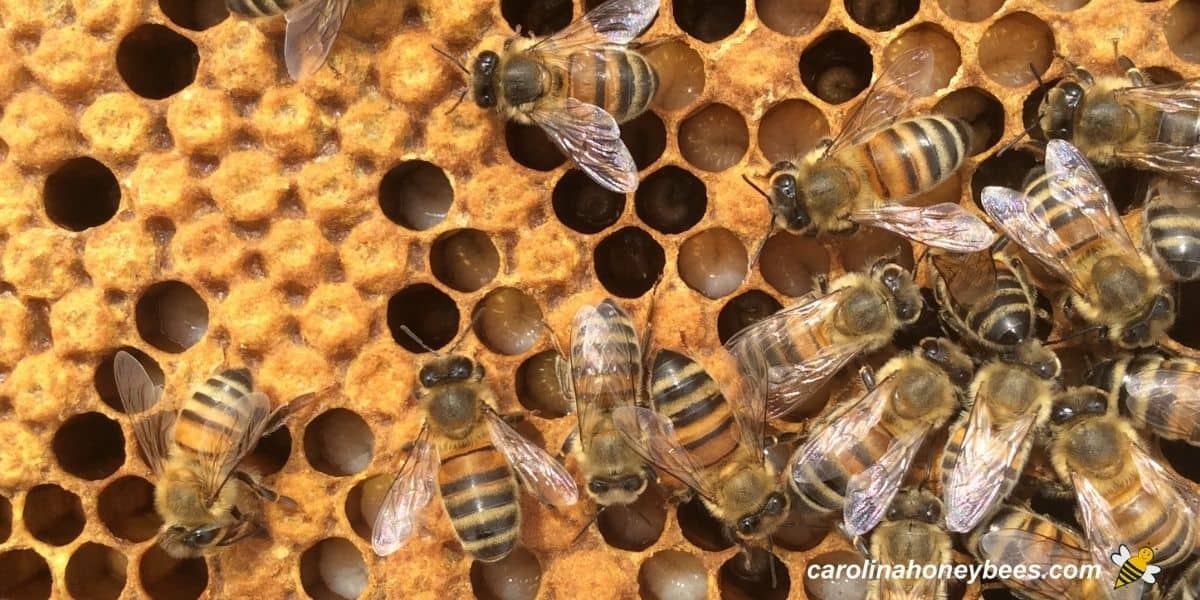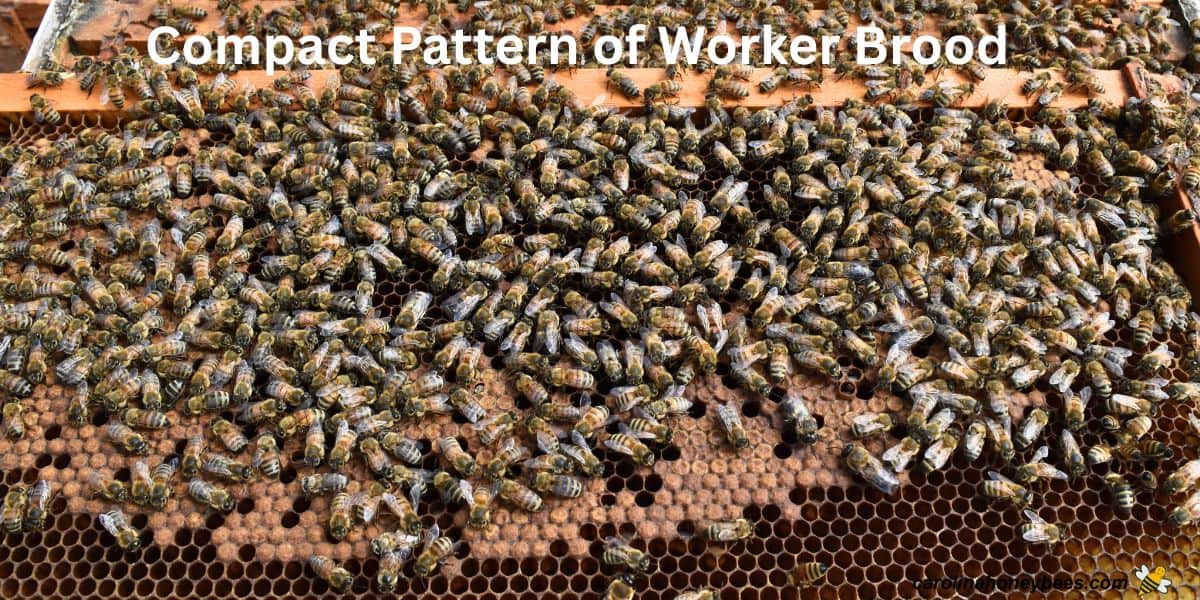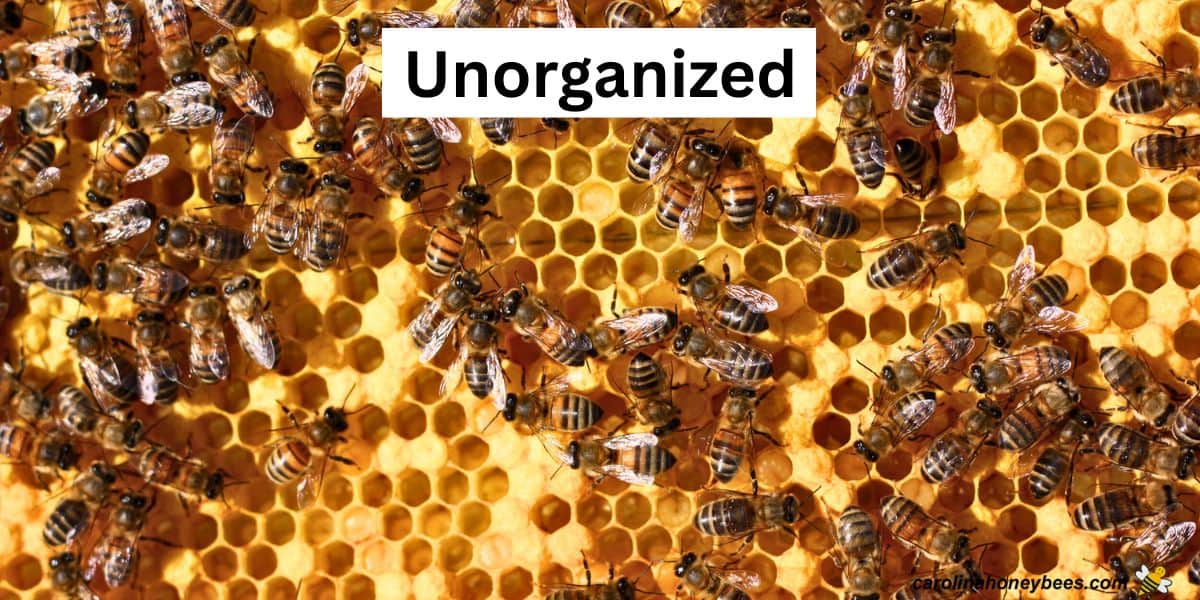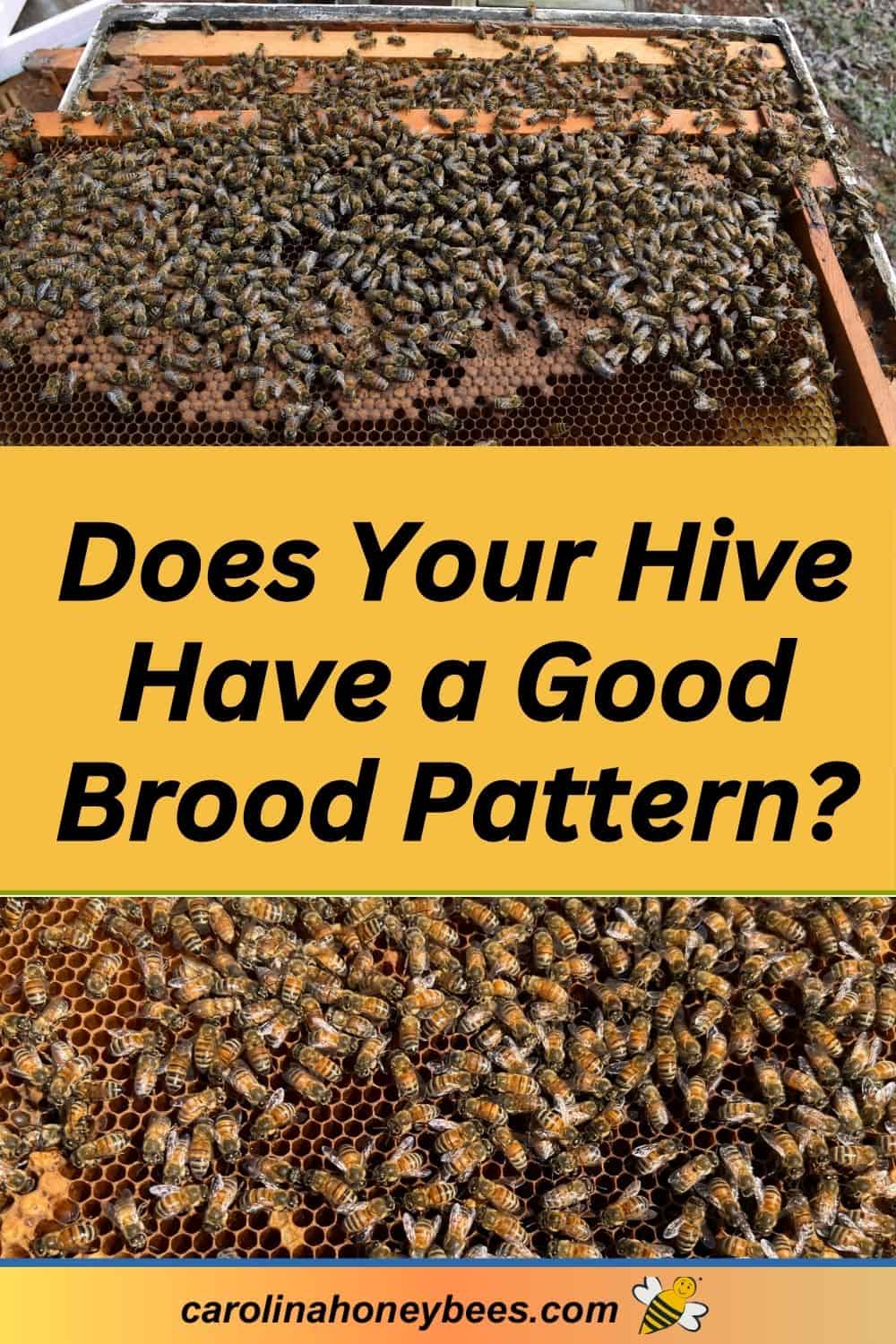A Good Brood Pattern
Every beekeeper needs to learn how to evaluate the brood pattern in your hives. Among beekeepers, it is common for someone to ask “do you have a good brood pattern?” But what does this mysterious term really mean and why do beekeepers care so much about it? In this article, we will cover some basics of evaluating brood in your colonies.

During the warm season, the colony should have a steady supply developing bees. These young bees or (bee brood) will replace adults that are dying of old age. It is the beekeeper’s job to monitor hive conditions and watch for problems.
What Does a Healthy Brood Pattern Look Like?
A healthy brood nest is a well-organized area within the hive where developing bees progress smoothly through their life stages.
When evaluating a brood pattern, beekeepers should look for a few key characteristics that indicate a strong and thriving colony.
Key Indicators
- compact uniform pattern
- all brood stages
- healthy capped brood
- ratio of worker vs drones
- food near the nest
- active caretakers

Uniform Brood Pattern
A strong queen lays a consistent tight pattern. There will not be large gaps of empty cells separating the occupied cells. This would be a spotty brood pattern.
Having young grouped together makes it easier to feed them and maintain the right temperature and humidity. Imagine trying to do that if they were scattered across all comb inside the hive with a patch here and there.
All Stages Present
A growing brood nest will have all stages of development present. This includes: bee eggs, developing larvae, capped brood and of course adult bees at work.
Seeing all three stages means the queen is actively laying, and the colony is raising new workers consistently.
Healthy Capped Brood
Once the growth stage is complete, workers will cap the cells with a wax covering. Inside, the young bee goes through the pupal stage before emerging as an adult. Adulthood is the final stage of the honey bee life cycle.
Capped worker brood should appear uniform in color—light brown or tan—and slightly domed. The cappings should be intact and dry, without sunken or perforated areas, which can indicate disease.
Dead brood with sunken caps can always be a possible sign of disease such as – American Foul Brood.
Ratio of Worker vs Drone
Most of the capped brood in a colony should be worker brood with a relatively flat wax capping. Worker bees are the backbone of the colony and thousands are required to keep the hive functioning.
Cappings protruding from the comb surface contain drone larva. Drones are male bees – they are needed to mate with virgin queens.
The amount of drone brood in the hive varies with the season. But, it should never represent the majority of developing young. Too many drones can signal a problem with your queen. A drone laying queen is a death sentence for the colony.
Stored Food Nearby
A strong colony maintains a supply of pollen and nectar (or honey) around the brood area. This helps workers serving as nurse bees feed the ravenous larvae.
Pollen cells (bee bread) are typically packed along the edges of the brood nest, while nectar or capped honey is stored above.

Evaluating Brood Patterns – Good or Bad?
So many factors affect the performance of a honey bee colony that we must avoid a rush to judgement if things don’t look perfect. Further evaluation may be necessary before taking action.
Compact Brood Pattern
A good brood pattern is a beautiful sight. It may be a small area comb (early in the season) or cover several frames in the hive.
The pattern usually begins in the center of comb section and moves outward towards the edges. Most cells within the area are in use.
All stages of development are generally grouped by type. Eggs are close to more eggs, larva of the same age close together, etc.
It becomes easy to identify a tight pattern once you understand what to look for. However, absence of a perfect brood nest does not always mean that your hive is in trouble.
Healthy Larvae
Bee larvae look like little white threads (c-shaped) laying in the bottom of a cell. As they grow, they become easier to see and fill the bottom of the wax cell.
Brown or discolored larvae may be a sign of disease. American Foul Brood gives off a “dead animal” smell while European Foul Brood smells sour.
Don’t panic over a small number of dead larvae if most of it looks good. Some conditions can cause the death of a small amount of brood but the colony recovers with time.
However, these situations should be noted in your beekeeping journal and monitored.

Worker Brood Present
Do you have worker brood? During most of the year- you should always see some worker brood in the hive.
Capped worker brood has wax coverings that just barely raise above the surface of the comb. Drone cells protrude from the comb like a bullet shape.
They are usually located on the edges of the brood nest area. We want drones – but we do not want all the capped cells to be drones.

One Egg Per Cell
Normally, the queen lays one egg per cell. Seeing multiple eggs per cell can signal a queen problem and possibly laying workers.
However, a young queen will often have a few mishaps in her first days of laying. If you have a newly mated queen, give her a week or so to work things out. Then check again.
Common Signs of Trouble

Scattered Brood #1
An non-compact brood pattern is one of the most common problems that hobby beekeepers face. It is also called “shotgun” or “ a pepperbox” brood pattern.
Several sections of brood will be scattered here and there with many empty cells in between. There are several factors that cause a poor brood pattern. These include: a failing queen, poor colony nutrition or even disease.
In my experience, scattered brood is most commonly caused by a problem with my queen. Requeening the hive is usually recommended if the problem is caught in time.

Most brood patterns will not be excellent or horrible but somewhere in between. In a case like the above image, brood of the same age are not concentrated together. Not ideal.
Yet, we do see all stages of development. This might be a case of close monitoring to see if the condition improves – or queen replacement (depending on the time of year).
No Brood – Especially Eggs
While the role of the queen bee is to lay eggs – she is affected by things beyond her control. Seeing no eggs is not automatically a sign that you have a bad quen.
The amount of food coming in affects the amount of brood rearing taking place in the hive. Egg laying is reduced or temporarily stopped during a nectar dearth. If food availability picks back up, brood rearing increases too.
Disease or pest problems also affect the amount of young bees in the colony. High infestations of varroa mites may result in bad brood patterns.
Genetics play a role in the size of brood nests too – some types of honey bees or bee breeds naturally keep larger brood nests.
If you keep bees that are being developed for hygienic behavior, you will see more empty cells in the nest area.
These bees are selected for their ability to recognize and remove mite infected brood. Routine hive testing for varroa mites is always advised.
As the queen ages, expect her laying rate to reduce until eventually the bees kill their queen and replace her. Or you can do the job for them.
All Drones – Oh NO
All drones in the brood nest is never okay. If you have all drone brood, laid together in a tight pattern – you may have a drone laying queen.
Perhaps she has run out of stored semen and can no longer fertilize eggs? Help them replace her if the colony population is good or buy a queen.
Scattered drone cells and no worker brood is an emergency. It is time to take action to help that colony by combining the hive with another colony or get them a new queen before laying workers develop.
FAQs
A good brood pattern in a beehive exists when healthy bee brood are arranged in a compact area with few open cells. By contrast, a poor brood pattern displays disorganization with brood scattered across the comb and many open cells.
The brood nest refers to the area on the combs where bees are rearing young. The brood nest does not remain in the same area all year. Over time, the bees may move to another box or section for brood rearing.
The brood pattern is located where the queen bee is laying eggs and larvae are developing. Beekeepers refer to the box holding frames of brood as the bee brood box. While it is often a deep sized hive body – it could be any size!
Final Thoughts
While it is easy to recognize a great healthy pattern or a really bad one, it is not always easy to evaluate one that is in the mid range. There are many variables involved in the amount of young reared by a colony.
The amount of brood in the hive will vary with local conditions and the time of the year. However, routine hive inspections allow the beekeeper to watch for brood pattern problems.
Additional Resources:

